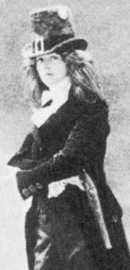Renée Vivien facts for kids
Renée Vivien (born Pauline Mary Tarn; 11 June 1877 – 18 November 1909) was one of the first twentieth-century lesbian British poets. [p.12] She wrote in French, in the style of the Symbolistes and the Parnassiens. Many of her poems are autobiographical, pertaining mostly to Baudelarian themes of extreme romanticism and frequent despair. Apart from poetry, she wrote several works of prose, including L'Etre Double (inspired by Coleridge's Christabel), and an unfinished biography of Anne Boleyn, which was published posthumously. She has been the object of multiple biographies, most notably by Jean-Paul Goujon, André Germain, and Yves-Gerard Le Dantec.
Biography
Early life
Renée Vivien was born Pauline Mary Tarn in London, England to a wealthy British father, John Tarn, and an American mother, Mary Gilett Bennett. John Tarn earned his wealth from property investments. In 1883, while attending the Belsize College in Hampstead, London, the Alliance française awarded a silver medal to her for her study of French in France. Vivien was attending school in Paris when her father died in 1886. Upon his death, Vivien returned to London to find that her father's inheritance was given to her. She was then taken away from her mother to live as a ward of the court until she came of age. In 1899, after she turned 21, Vivien returned to France with the inheritance money. It is around this time that she began to be known as Renée Vivien.
World travels
Vivien was cultivated and very well travelled, especially for a woman of her era. She wintered in Egypt, visited China, and explored much of the Middle East, as well as Europe and America.
Vivien went to Japan and then Hawaii with her mother in 1907. Vivien became ill on the voyage.
Her Paris home was a luxurious ground-floor apartment at 23, avenue du Bois de Boulogne (now 23, Avenue Foch) that opened onto a Japanese garden. She purchased antique furnishings from London and exotic objets d'art from the Far East. Fresh flowers were abundant, as were offerings of Lady Apples to a collection of shrines, statuettes, icons, and Buddhas.
A public square is named in her honor in Paris: Place Renée-Vivien, in Le Marais, central historic district of the French capital.
Death
Vivien died in Paris on the morning of 18 November 1909 at the age of 32; the cause of death was reported at the time as "lung congestion".
Works
Published works
Vivien only wrote in French. Some of her works have been translated.
She published her first collection of poetry, Études et préludes, in 1901. She would go on to publish 12 more collections of poetry in her lifetime, as well as her own translations of Sappho's verses from Greek (the language she learnt specifically for the purpose).
In 1903, Vivien produced a translation of Sappho's poetry from the edition of Hentry Thornton Wharton, entitled Sapho, traduction nouvelle avec le texte grec (Sapho: A New Translation with the Greek Text). [p. 78] She learned Greek by taking private lessons with a teacher, Gaetan Baron, because she wanted to read Homer in the original Greek. [p. 93] In 1904, Vivien originally published A Woman Appeared to Me (in French), an autobiographical novel. In 1976, it was translated to English by Jeanette Foster and published by Naiad Press. Naiad also published a translation of Vivien's poetry collection, The Muse of Violets, in 1977.
Vivien also published poetry and prose in collaboration with lover, Hélène van Zuylen using the pseudonym, Paule Riversdale. The true attribution of these works is uncertain, however; some scholars believe they were written solely by Vivien. Even certain books published under Zuylen's name may be, in fact, Vivien's work.
During her brief life, Vivien was an extremely prolific poet who came to be known as the "Muse of the Violets", derived from her love of the flower. Her obsession with violets (as well as with the colour violet) was a reminder of her beloved childhood friend, Violet Shillito.
She took to heart all the mannerisms of Parnassianism and of Symbolism, as one of the last poets to claim allegiance to the school. Her compositions include sonnets, hendecasyllabic verse, and prose poetry.
Virtually all her verse is veiled autobiography written in the French language; most of it has never been translated into English. Her principal published books of verse are Cendres et Poussières (1902), La Vénus des aveugles (1903), A l'heure des mains jointes (1906), Flambeaux éteints (1907), Sillages (1908), Poèmes en Prose (1909), Dans un coin de violettes (1909), and Haillons (1910).
Her poetry has achieved greater appeal and a wider audience due to the contemporary rediscovery of the works of the ancient Greek poet Sappho.
Gallery
-
Renée Vivien (left) and Natalie Clifford Barney posing for a portrait in Directoire-era costume
-
Lucien Lévy-Dhurmer (b. 1909), Portrait of Renée Vivien
See also
 In Spanish: Renée Vivien para niños
In Spanish: Renée Vivien para niños









